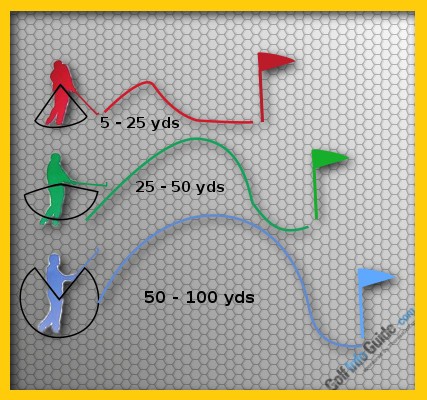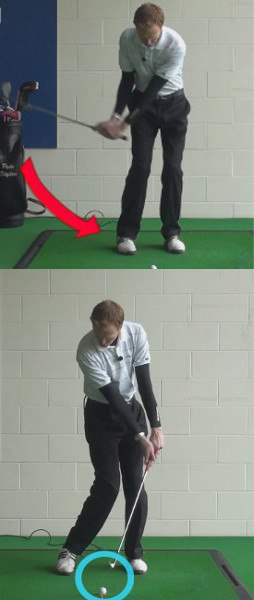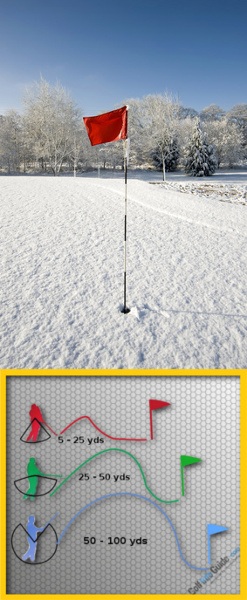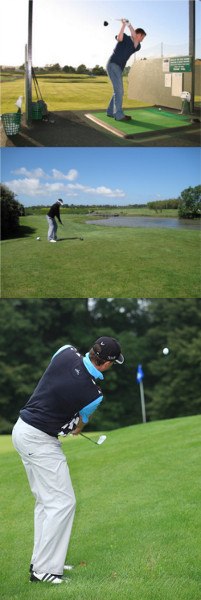
Do you struggle to get really close to the golf ball when hitting from 100 yards and in?
Do you find distance control hard to master? This drill has the perfect answer to your problems. Missing the green or not getting close enough from just 100 yards can seriously affect your score and can cause strain on your chipping and putting. With the following advice you will be able to control your distance with all wedges to make sure you can most effectively approach any distance from 100 yards and in with confidence and precision.
Wedge make up - A good starting point is to make sure you have sufficient gaps between your wedges. Make sure you carry enough wedges to be able to cover most distances from 100 yards and in. Work out how far you hit your driver and how far you hit your full pitching wedge. From this, work out the difference between the two distances and divide it by how many clubs you have that covers that distance.
For example: Driver distance = 220 yards, Pitching wedge = 100 yards (difference is 120 yards). Clubs that cover that difference - Driver 3 wood, Hybrid, 4, 5, 6, 7, 8, 9, pitching wedge (10 golf clubs), 120 yards/10 clubs = 12 yards per club.

Work out how many clubs you carry between your full wedge distance and a distance of only 20 yards. For this example that would equate to 80 yards. Pitching wedge, gap wedge, sand wedge and lob wedge = 20 yards per club. From this breakdown we can start to identify any gaps or weaknesses within the clubs that you carry so that the gaps can be appropriately filled.
Learn to control the length of each club by imagining you have a clock face around your golf swing. 6 o'clock is where the golf ball is and 12 o'clock is directly above your head. Use the imaginary clock face to judge the length of your back swing and follow through. To make sure you do not decelerate during the golf swing always make sure your follow through is the same length as the backswing. Use the clock face then to help control the ball flight. For short chip shots, swing from 8 o'clock to 4 o'clock, medium shots from 9 o'clock to 3 o'clock, longer shots from 10 o'clock to 2 o'clock, and almost full shots from 11 o'clock to 1 o'clock. For roughly each hour difference, the golf ball will travel ten to fifteen yards difference.
Creating a wedge chart is an easy way to take out the guess work from your wedge play. You can accurately choose a club on the golf course from any distance 100 yards and in so that you can hit precise distance shots at the flag. The best way to create a wedge chart is to use a flat practice ground without any wind factors that will affect the golf ball's flight. Hit each club 10 times at all the different times of swings as discussed earlier. Take an average of the 10 shots with each club to work out the distance, either by pacing the shots out or by using a measuring device with each club and each time.
This will provide you with an extensive wedge chart for all distances from 100 yards and in that you can note down and carry around with you when you are out on the golf course.

Ultimate Distance Control from 100 Yards and In
If you want to play better golf, you will focus on improving your game from 100 yards and in. Despite the fact that many golfers spend the majority of their time working on their driver swing, the real key to playing great golf is being able to handle the short shots successfully. When you can consistently play quality shots from inside of 100 yards, you will be able to shoot impressive scores even if your full swing is giving you problems. Step your game up from close range and you will see your scores quickly start to fall.
The primary objective on any shot from closer than 100 yards is getting the distance of the shot correct. It isn't hard at all to get the ball on the right line from less than 100 yards, so your focus should shift to dialing in your distance control perfectly. You are unlikely to hit the ball more than a few yards off line from close range, so a shot that has proper distance is likely to finish close to the hole. If there is one area of golf where professionals have the largest advantage over amateurs, it is their distance control on short shots. You will be amazed at the improvement of your game as a whole when you can simply learn how to hit the ball the right distance time and time again from inside of 100 yards.
There are a number of factors that play into process of hitting the ball the correct distance. A few of the elements that you will need to understand include the following –
- Picking the right club. Many golfers will simply reach for their sand wedge or lob wedge when they are inside of 100 yards, but that isn't always the right choice. You need to understand the options you have with your various wedges before selecting the right one of the shot.
- Your swing mechanics. The swing that you use from close range will have to be modified slightly from your normal full swing. Practicing these mechanics, and understanding how they work, is key to successful distance control.
- Conditions of the course. The shots that you will use from inside 100 yards will also vary based on the conditions of the course. If the course is dry and firm, you will need to employ different tactics than if the course were playing damp and soft.
- Hazards around the green. You don't want to make the mistake of overlooking the terrain around the green when selecting and hitting a shot from less than 100 yards. If there is a water hazard in front of the green, or a deep bunker positioned near to the hole, you will need to factor those dangers into your pre-shot planning.
A golfer who is able to dial in their distance from inside of 100 yards is a player who should have plenty of great chances to make birdies and save pars. Mastering this part of the game is exciting because it will give you the confidence you need to play the course aggressively, knowing you can always bail yourself out of trouble with a great wedge shot.
All of the instruction contained below is based on a right handed golfer. If you play left handed, please be sure to reverse the directions as necessary.

The Easy Way to Pick the Right Club
Any time you approach your ball and find that you have less than 100 yards to the hole, you are probably looking at hitting one of your wedges. Most golfers can at least hit their pitching wedge in the range of 100 yards or so, if not farther. Therefore, you are going to be picking between three or four clubs for the shot, depending on how many wedges you carry in your bag. However, don't make the mistake that so many others golfers make by simply reaching for the most-lofted club that you have available for the shot. Instead, use the following method to guide your club selection and your distance control will improve almost immediately.
- The first step in this method is to establish two different distances for the shot – the distance that you have remaining to the hole, and the distance that you have remaining to the front of the green. It is important that you take the time to find both of these numbers so you can make an informed decision regarding club selection. If you carry a range finder, it should take only a few seconds to find the distance to the hole. The distance to the front of the green may be more difficult. This number is usually offered on GPS units, so that may be an option. Also, the golf course you are playing may offer a yardage book which will give you this crucial number. As a last resort, you could always estimate the yardage to the front of the green based on the yardage that you have left to the hole.
- One you have those two yardages in your head, you will need to subtract the front of the green yardage from the total yardage to the hole. This quick mental calculation will give you the number of yards between the front of the green and the hole – and this number is critical, as it is going to be the basis for your club selection.
- Now that you know how much room you have to use in front of the hole, pick the club that will keep the ball the closest to the ground while still landing the ball on the green and stopping it near the hole. The whole idea of this method is to keep the ball low and control your shots from inside of 100 yards. When you hit the ball high up into the sky, you lose control over how far the shot flies, and you will have trouble controlling the spin as well.
It will help to highlight this method with an example. Imagine that you have hit a beautiful drive on a par four and you have 80 yards left to the hole, with 65 yards to the front edge of the green. From past experience, you know that you can hit your sand wedge 80 yards, your gap wedge around 95 yards, and your pitching wedge around 110. Therefore, any of the three clubs could technically work for this shot. Instead of reaching for the sand wedge, you should pick the club that you believe you can stop using the 15 yards of green that you have to work with.
The gap wedge is almost certainly a good option, as it shouldn't be hard to stop the ball with that much room to work with. Depending on the conditions of the course, you may even be able to stop the ball with your pitching wedge. The sand wedge should be your last choice in this scenario, even though it is technically the perfect yardage for the shot. Making a full swing with the sand wedge, however, is going to put a ton of spin onto the ball and send it way up into the air. Instead, you should opt to maintain control over the shot by using either the gap wedge or pitching wedge and hit a soft, low shot into the green.
This method will take some practice before it is going to be an effective and reliable part of your game. Your natural instinct is probably to select a club that you can hit hard in this situation, but that approach is never going to allow you to consistently stop the ball near the hole. Learn how to hit low shots into the green from 100 yards and you will be a better player in the long run.

The Proper Mechanics for a Soft Wedge Shot
In order to successfully lower your ball flight on wedge shots of less than 100 yards, you will need to make some minor adjustments to your swing mechanics. You don't want to totally change your swing – you only want to modify some of the elements of your set up and follow through to facilitate the ball flight you are trying to achieve. Of course, it is important that you spend some time learning these changes on the driving range before you attempt to use them on the course.
Below are three key alterations that you should consider making to your swing technique in order to hit low wedge shots.
- Move the ball back in your stance. This is an easy step to take that should quickly allow you to hit a lower ball with your wedges. While many golfers know of this adjustment, some take it too far and they end up playing this kind of shot with the ball lined up off their back foot. If you move the ball too far back, you will be making your swing excessively steep and it will be difficult to make solid contact. In reality, you only want to put the ball just an inch or two behind the middle of your stance. If you normally play your wedges from the middle of your stance, move the ball back by a couple of inches and you should be ready to go.
- Choke down on the grip. This is an adjustment that goes hand-in-hand with the change in ball position. If you were to try hitting these shots while keeping your hands at the top of the grip, you would likely hit the ball fat more often than not. Choke down just an inch or two so you can gain some additional control over the club throughout the swing.
- Finish low. You don't want to swing up into a full finish when trying to hit a low wedge shot. A full finish means that you have released the club through impact – and that is not what you are trying to do in this case. Focus on keeping the club relatively low to the ground during your follow through. This will limit the amount of release that you get through the ball, and the shot should fly low to the ground as you were intending.
The only way be become comfortable with these low wedge shots is to hit them over and over again on the driving range. Pick out some short range targets and try to dial in your distance control for a variety of yardages. This is not a challenge that you are going to conquer in one quick range session – instead, you should plan on making these kinds of shots a regular part of your practice routine so you can get better and better at them as time goes by.
If you would like to use a practice drill at the driving range to focus your practice time, try following the steps below.
- Using your gap wedge or sand wedge, set aside five golf balls for the drill.
- Pick out two targets on the range – one should be around 40 or 50 yards, and the other should be around 70 or 80 yards.
- With the first ball, try to hit a shot as close to the first target as possible. Don't worry about the bounce of the ball when it lands on the range – just focus on your carry distance for this drill.
- After you hit the first shot, set up for the next shot with the idea of hitting it close to the longer target. Again, try to land the ball as close to the target as you can using your modified swing mechanics.
- With the third ball, move your aim back to the short target. On the fourth ball, go back to the long target, and then finish by hitting the fifth shot halfway between the two targets.
If you follow the steps of the drill, you will have hit two shots around 40 – 50 yards, two shots around 70 – 80 yards, and the last shot right in the middle. This drill will only take you a couple of minutes to complete, but it will help you learn how to vary the speed of your swing to hit the ball different distances. If you incorporate this drill into your regular practice routine you should quickly improve on shots from these awkward distances.

Pay Attention to Course Conditions
One of the things that makes golf such a challenging game is the fact that the course conditions are ever-changing. You can play the same course today and tomorrow and encounter significantly different conditions based on weather, maintenance, etc. While it can be frustrating to have to adapt to the course at all times, this is also one of the reasons that golf never gets old – each round is a new challenge.
When you are getting ready to play a round of golf, pay particular attention to the condition of the practice putting green. Most golfers at least hit a few putts to get an idea of the speed of the greens that day, but your analysis should run deeper than that. Beyond the speed of your putts, you also want to know how the ball is going to react when it lands on the green. Is the ground dry and hard, or wet and soft? Somewhere in between? The specific turf conditions that exist during that round will determine how you play your approach shots from inside 100 yards.
If you are playing a course that has soft greens, perhaps due to recent rain, you will have to adjust your game plan accordingly. Instead of landing the ball near the front of the green and playing for a bounce, you will need to hit the ball almost the entire distance to the hole. A soft green isn't going to give you a reliable bounce, so you will want to take the guesswork out of the shot and simply try to fly the ball right next the hole. Since the greens are soft, you shouldn't have any trouble getting the ball to stop quickly after it lands.
When you encounter hard greens which are offering big bounces, you will want to find the right balance of trajectory and spin to get the ball to stop at the appropriate distance. There is no science to this part of the game, as you will have to learn the 'feel' for judging the greens and hitting the right shot for the situation. Remember, the condition of the greens can even change during a round of golf, so you need to remain aware throughout the day. If the sun comes out in the afternoon and warms up the course, the greens are likely to get firmer. On the other hand, a quick rain shower can soften the course and allow you to be more aggressive.
A good golfer is always paying close attention to the conditions of the course, from the first shot to the last. Think of the course as the defense that you are playing against – you always want to know what the defense is doing, so you can respond with the right shot selection. If you ignore the condition of the course and simply try to do your own thing, you will never reach your potential when it comes to distance control inside of 100 yards.

Proceed with Caution
The natural tendency for most golfers is to be aggressive with their shots from inside 100 yards. Usually, this is a good idea – shots from less than 100 yards are relatively easy, and you should be trying to get the ball close to the hole. However, when there is a hazard waiting around the green that could add penalty strokes to your scorecard, you will want to think twice and proceed with caution.
Most often, a golf course designer will position a hazard near the front of the green. Think back to our earlier example of an approach shot were you have 80 yards remaining to the hole, and 65 yards to the front edge of the green. Only this time, add in a pond that protects the front of the green. So, a shot of 65 yards will land your ball on the green, but 60 yards will mean your ball is in the water. Although nothing has changed in terms of the green itself, you will want to take a completely different approach to the shot.
Instead of bringing the ball in low, you now want to hit a high shot that flies all the way to the hole. It would be a mistake to play a low shot in this situation because you would be providing yourself with very little margin for error. If you aim to hit your shot 65 yards in the air, it doesn't require much of a miss-hit to come up short and land it at 60 instead. Normally, that wouldn't be a big deal. In this case, however, coming up five yards short means a penalty shot and having to drop your ball to pitch again.
That is exactly the outcome you need to avoid. By playing a high shot that lands around 80 yards instead, you can provide yourself with plenty of margin for error. Even if you miss-hit the 80 yard shot slightly, it should still clear the hazard and allow you ball to land safely on the green.
Controlling your distance from inside of 100 yards is about more than physical skill. Sure, you need to execute your swings properly, but you also need to make good decisions and consider all of the variables that are in play. Generally speaking, you want to hit your wedge shots low to the ground when playing from inside 100 yards, but there are exceptions to that rule (such as the previous example). Make sure that you spend plenty of practice time learning how to control these important shots so you can execute them beautifully during your next round of golf.






